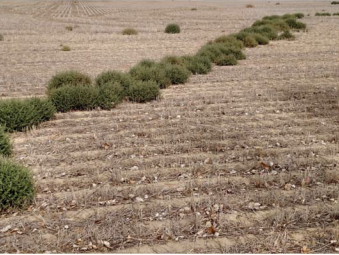
Herbicide-Resistant Plants: Russian Thistle
Herbicide-resistant plants often develop from repeated use of a single mode of action herbicide. Plants can then develop resistance to additional herbicides, and then require integrated, and more costly, crop management techniques.
Last Updated: 08/18by Jesse Fulbright, Adriane Good, Prashant Jha, Kari Lewis, Tyler Lane, Peggy Lamb, and Brent Roeder – Montana State University-Bozeman
Russian thistle (Salsola tragus L.) is a severe and problematic annual broadleaf weed in dryland spring wheat and summer fallow and in other crops such as pulses and oilseeds. If not controlled early, Russian thistle can reduce yields up to 50%. Russian thistle exhibits early seedling emergence in the spring, producing more than 100,000 seeds per plant, which are dispersed as the mature plant breaks off and tumbles across the landscape. The plant is also capable of vigorous regrowth after wheat harvest, producing up to 17,400 seeds per plant. Up to 99% of seeds from Russian thistle emerge in the first year.
Herbicide Resistance Cases
As of March 2018, glyphosate-resistant Russian thistle has been identified in Chouteau County, with more counties likely to be added as testing continues. Glyphosate-resistant Russian thistle has resulted from the repeated use of a single mode of action herbicide, i.e. glyphosate, for weed control for decades. Group 2-resistant Russian thistle was first identified in Montana wheat fields in 1987. Since then resistance to this Group of herbicides (thifensulfuron, tribenuron, metsulfuron) has continued to increase.
Integrated Management Techniques
To combat glyphosate-resistant Russian thistle, it is critical that a multi-faceted approach be utilized. Herbicide-resistant Russian thistle developed due to repeated herbicide use and must be addressed with a more diversified weed management approach.

Recommendations
- Prevent seed production – destroy any plants that survive herbicide application prior to flowering using alternative herbicides, handpulling, or tillage.
- Diversify crop rotation – integrating pulse crops into wheat rotations adds diversity to weed control options.
- Increase crop competitiveness – decrease row spacing, increase seeding rate, and adjust planting dates.
- Use green manure – incorporate legume green manure into the rotation instead of fallow to reduce the number of burndown applications needed.
- Manage field borders – allowing resistance-prone weeds to produce seed in field borders may make resistance problems worse.
- Clean planting, tilling, and harvesting equipment to reduce the spread of resistant weed seeds into uninfested fields.
- Limit bare fields to reduce the spread of Russian thistle if it has been allowed to go to seed.
Herbicide Applications
- Apply herbicides at labelled rates – repeated exposure to low doses of herbicide allows weeds to develop resistance.
- Scout fields regularly – scout prior to and after spraying and destroy any surviving weeds immediately.
- Diversify herbicides – rotate herbicide modes of action (Groups) and use tank mixes with multiple modes of action to avoid developing resistance. Use recommended rates of adjuvants, water conditioners/pH buffers to enhance herbicide efficacy.
- Use best herbicide application techniques by reading and following the pesticide product label – improperly calibrated sprayers, incorrect nozzles, low (< 10 GPA) spray volumes, poor water quality, dusty and hot/dry weather conditions decrease herbicide effectiveness and can perpetuate resistance.
- Target Russian thistle in the early spring for effective control. Plants should be sprayed as early as 3-4 inches of growth with post-emergence herbicides listed in Table 1.
- Use fall-applied soil-residual herbicides including Valor SX, Metribuzin 75 DF, Authority MTZ, and Spartan Charge for extended residual activity into the following season and reducing selection pressure from glyphosate burndown. When applied in the fall, these herbicide programs also minimize the risk of injury to dry pea under unfavorable conditions in the spring. This list represents only a few products that can be used to manage Russian thistle.
Glyphosate-resistance Testing
Growers who suspect a glyphosate-resistant weed population should contact their local MSU Extension office for instructions on submitting a sample for testing. Testing is offered as a free service through the MSU-Southern Ag. Research Center Weeds Lab, at 748 Railroad Highway, Huntley, MT 59037. Phone: 406-348-3400.
References and for more information
Kumar et al., 2017, Glyphosate-Resistant Russian thistle (Salsola tragus) Identified in Montana and Washington.
Acknowledgement
This material is based upon work that is supported by the National Institute of Food and Agriculture, U.S. Department of Agriculture, under award number EW16?029 through the Western Sustainable Agriculture Research and Education program under subaward number 150893?00001?207. USDA is an equal opportunity employer and service provider.
| Wheat/barley | Talinor | Post-Emergent | 13.7 fl oz/a |
6+27 |
| Wheat/barley | Bronate Advanced | Post-Emergent | 25.6 fl oz/a | 4+6 |
| Wheat/barley | Starane NXT | Post-Emergent | 27.4 fl oz/a | 4+6 |
| Wheat/barley | Huskie | Post-Emergent | 15 fl oz/a | 6+27 |
| Wheat/barley | Kochiavore | Post-Emergent | 1.5 pt/a | 4+6 |
| Burndown | Sharpen + 2,4-D LV4 | Post-Emergent | 2 fl oz/a + 8 oz/a | 14+4 |
| Burndown | Gramoxone SL | Post-Emergent | 32-48 fl oz/a | 22 |
| Burndown | Kochiavore | Post-Emergent | 2.5 pt/a | 4+6 |
| Dry Pea | Metribuzin 75 DF | Pre-Emergent | 4-8 oz/a* | 5 |
| Dry Pea | Sharpen | Pre-Emergent | 1-2 fl oz/a | 14 |
| Dry Pea | Spartan Charge | Pre-Emergent | 3-7.75 fl oz/a* | 14 |
| Lentil | Prowl H2O + Outlook | Pre-Emergent | 1.5 –2 pt/a + 16-21 fl | 3+15 |
Use recommended adjuvants with all post?emergence herbicides as per the herbicide label directions. Follow application timings and crop rotation intervals.
* Adjust rates based on soil texture, pH, and % organic matter.

